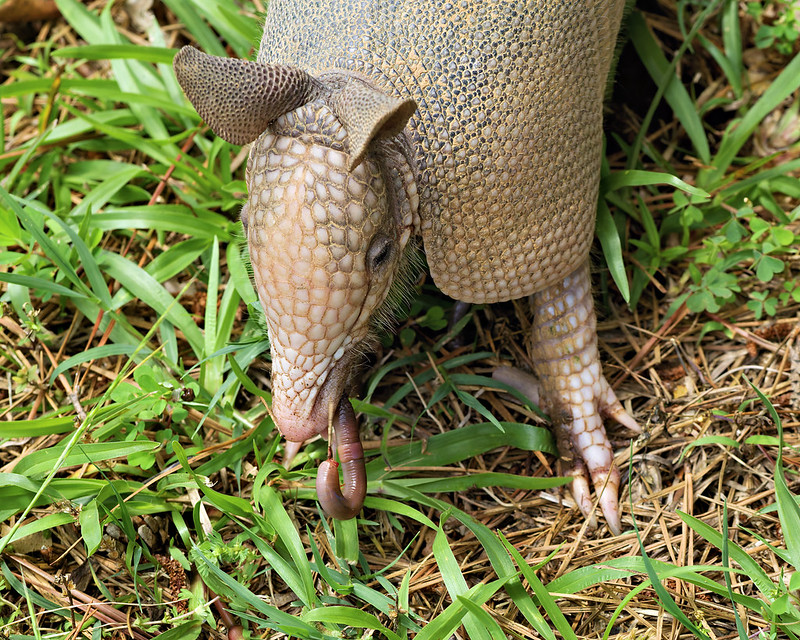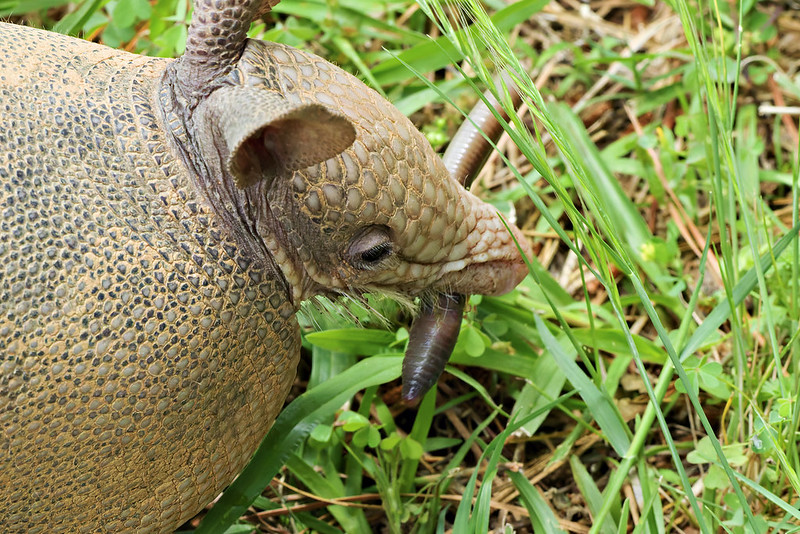On a recent day in my Arkansas yard, I watched a young Nine-banded Armadillo foraging through the grass. It moved slowly but deliberately, using its keen sense of smell to search for food. As I followed it quietly with my camera, it unearthed an earthworm and began to eat. I managed to photograph the moment mid-snack, with the curled worm still hanging from its mouth.

Natural Feeding Behavior of Nine-Banded Armadillos
This juvenile armadillo offered a clear example of how these animals feed in the wild. While they eat a wide variety of insects, grubs, and other invertebrates, earthworms are a favored source of protein. The armadillo’s long snout and sensitive nose help it detect movement underground. Once located, it digs quickly with its sharp claws and snatches the prey with its sticky tongue.

Observing Young Armadillos Up Close in My Yard
It’s always rewarding to observe wildlife like this so close to home. This young armadillo didn’t appear to notice me as I stood quietly nearby. It was completely focused on foraging, moving methodically through the lawn. These moments are not only fun to photograph but also provide insight into the everyday lives of these often misunderstood animals.
Camera Gear and Settings
To photograph this armadillo, I used the Canon EOS R5 Mark II paired with the RF 100-500mm F4.5-7.1 L IS USM lens. My settings were:
- Aperture: ƒ/10
- Focal Length: 100.0 mm
- Shutter Speed: 1/1250
- ISO: 2000
- Exposure Mode: Manual
- Exposure Compensation: 0
These settings helped me freeze the action while maintaining sharp focus and detail.
Additional Nine-Banded Armadillo Behavior Observations
This wasn’t my first encounter with armadillos in my yard, but this was one of the most detailed views I’ve had of their feeding habits. The armadillo I photographed with the earthworm is one of four I wrote about in an earlier blog post: Baby Nine-Banded Armadillos in My Yard.
FAQ
What do Nine-banded Armadillos eat?
They primarily eat insects, grubs, and worms found in soil and leaf litter.
How do armadillos find earthworms?
They use a highly developed sense of smell to detect underground movement.
Are armadillos active during the day?
They are mostly nocturnal but can sometimes be seen foraging in the early morning or late afternoon.
Are armadillos dangerous?
No, they are generally harmless to humans and will avoid confrontation.
Can you approach a wild armadillo?
If you’re quiet and move slowly, it’s possible to observe them closely without disturbing them.

What fun to see the Armadillo pictures you posted. I saw my first one in Texas many years ago. I never thought much about what eat such as earthworms. Thanks for the information. They are cute little critters.